Battersea Power Station
|
Battersea Power Station was used as a base of operations for his sattelite ground station by Colonel Cobb in 'Monsoon Man', during which Ami revealed that she had once lived close to the site. The distinctive building also appeared briefly in the earlier story 'The Culex Experiment' in which Adam saw it from the rear of Culex's cattle truck. Battersea Power Station stands on the bank of the River Thames in central London, not far from Battersea Park rail station and clearly visible from railway lines out of London Waterloo or Victoria.
This defunct power station was designed by Sir Giles Gilbert Scott, first opened in 1933, was extensively modified in 1953, closed in 1983 and now stands derelict. There are plans for its conversion into a shopping and entertainment complex, first proposed in 1997 and with construction expected to start this year (2005). A recent visit by a BBC photographer produced this interesting record of the building's current state. (Map of this location) |
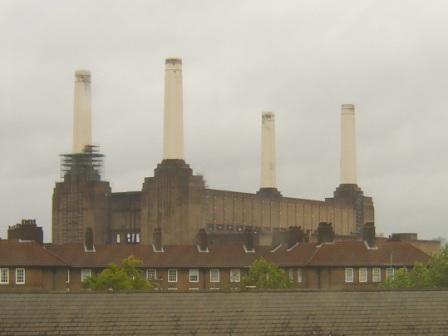
(Right) The abandoned Battersea Power Station as seen from the Eurostar rail line in May 2005. |
British Museum
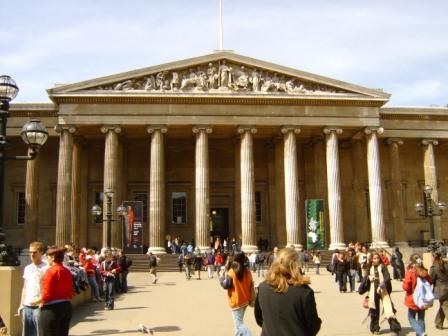 |
Not actually used in filming the series (see 'UCL Portico and Petrie Museum' above), the British Museum was visited by the Tomorrow People in 'The Rameses Connection' in their efforts to understand the warning they received from the past. The British Museum has an extensive collection of Egyptian antiquities - in particular the 'Rosetta Stone' which allowed the first translation of Egyptian hieroglyphs into other ancient and modern languages.
(Left) The main entrance and portico of the British Museum seen in May 2005. Compare with the UCL bulding facade above. |
The museum is open seven days a week and is free to visitors. It is located on Russell Street in central London and is easily reachable by tube (closest station - Tottenham Court Road) or bus routes. See the museum webpage for details. The British Museum was also mentioned in the OS serial 'A Rift in Time' in which it housed the 'gladiator vase' on which Peter had inscribed a plea for help (see 'Silchester', above) (Right) The British Museum's main entrance and showing some of the east wing. Seen in May 2005. |
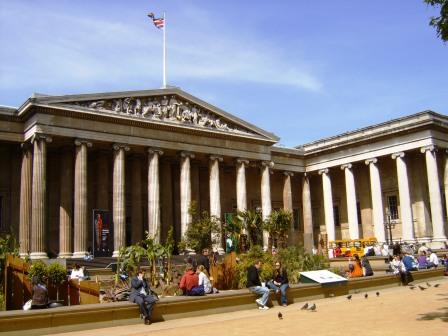 |
Camden Passage Market
 |
Camden Passage in the Angel region of North London appears in 'The Rameses Connection' as the location in which Ami and her mother shop for a birthday present - settling on a mysterious pendant.
Camden Passage, N1 is a cobbled street, lined by small but interesting shops selling a variety of curiosities. As well as a small antiques market, it also boasts bookshops and restaurants. Most traders are specialists, and prices may be high, but (according to one website) haggling may be possible. The nearest underground station is Angel - see Map. |
(Above and below left) Camden Passage Market, in January 2006. |
|
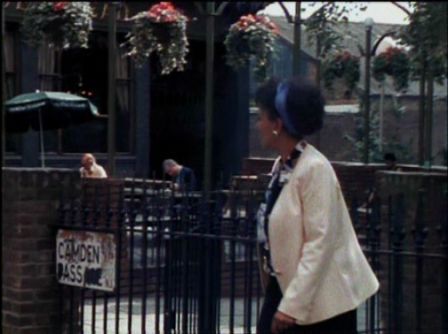 |
|
Canary Wharf
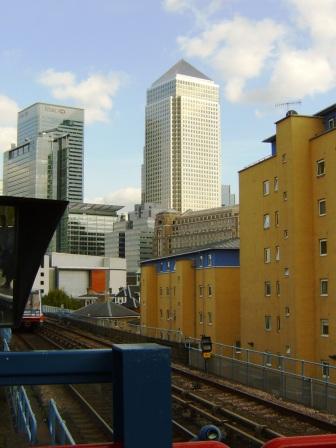 |
The pyramidal cap to this 800m tall office building played an important role in the story 'The Rameses Connection' in which the building features as the headquarters of Sam Rees. At the time the series was filmed, Canary Wharf tower (finished in 1990, and technically 1 Canada Square, Docklands) stood isolated and prominant in the London skyline. The tower is now flanked by two towers of almost the same height, also located on Canary Wharf - part of London's Docklands.
Much of the Docklands region was redeveloped in the late 1980s and early 1990s. The effects of this redevelopment, and the tower itself can be well seen from London's Docklands Light Railway (DLR). The tower itself is not open to the public. (Left) Canary Wharf tower as seen from the platform of the DLR station at Westferry. One of its two neighbouring towers (constructed after the series) is also visible. Seen in May 2005. |
Cleopatra's Needle
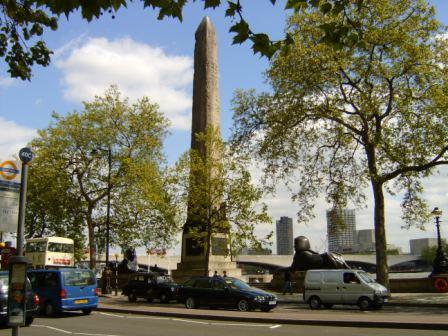 |
Visited by TPs in 'The Rameses Connection', the movement of Cleopatra's needle from Egypt to London was portrayed as part of Sam Rees's plan for world domination. In actual fact, Cleopatra's Needle is an obelisk carved to commemorate the pharoah Tuthmose III, and was one of several dating from the same period, including a second which was transported to New York and now stands in Central Park. (Left) Cleopatra's Needle and its pair of guardian sphinx as seen from the Thames Embankment in May 2005.
|
|
The London obelisk left Egypt in 1877 and was finally erected on the banks of the Thames in 1878 after an adventurous journey involving the loss of life for several seamen (as Millicent Rutherford notes on screen) and a near shipwreck.
Cleopatra's Needle stands on the London Embankment (the broad avenue on the north bank of the Thames, constructed on the nineteenth century as part of a massive program of sewage works). The mounting and viewing platform for the obelisk actually extends outwards over the Thames in order to allow the needle to be inspected from all sides, and the obelisk is flanked by two bronze sphinx. Its closest London Underground stations are Embankment and Charing Cross. (Right) The plaques on the base of Cleopatra's Needle describe its journey and commemorate the lives of those who died during its transportation. Seen in May 2005.
|
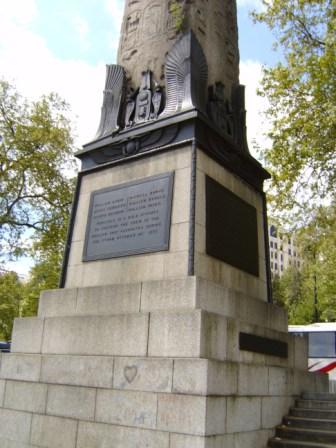 |
Hard Rock Cafe, London
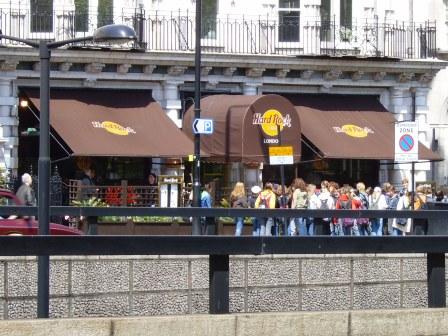 The Hard Rock Cafe, London, in May 2005. Seen from Piccadilly. |
The Hard Rock Cafe in London featured in the 'Origin Story'. Pre-breakout, but taken for a Tomorrow Person by Professor Galt, Megabyte gave his captors the slip while they stopped at the cafe.
The London Hard Rock Cafe is one of a worldwide chain of more than a hundred such venues, and was the first to be opened (in 1971). Founded by Isaac Tigrett and Peter Morton, it aimed to attract both celebrities and the general public in a 'Rock-and-Roll' atmosphere. The cafe has become famous too for its collection of music memorabilia which started with Eric Clapton's guitar. Combining live music with well thought of (American-style) dining, the Cafe on Old Park Lane, W1 is open daily. It can be reached by London Underground to Green Park (Victoria line) or Hyde Park (Picadilly line).
|
Imperial War Museum
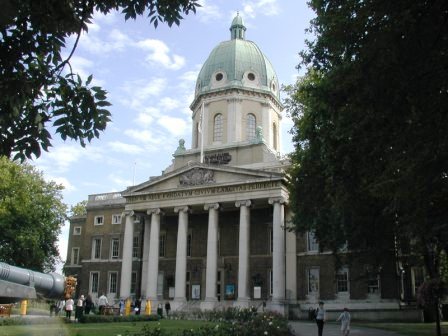 |
The Imperial War Museum was the location of a rendesvouz between Dr Connor and Dr Culex towards the end of 'The Culex Experiment'. Connor and her cornucopia machine were snatched out from under the noses of the Tomorrow People while standing outside the museum gates. (Left and Below) The Imperial War Museum, London in August 2005 (photographs by Wendy Perkins)
|
|
The Imperial War Museum is now a collective description for a number of sites across the UK, including the Duxford air museum and HMS Belfast on the Thames. The location in question here is now known as the IWM London and was the original museum of the name. The museum opened in 1920 and moved to its current location in 1936 and has been housed there ever since (excluding a period of evacuation during the Second World War. The current buildings originally formed part of the Bethlem Royal Hospital (the original Bedlam) until its move to Kent in 1930.
|
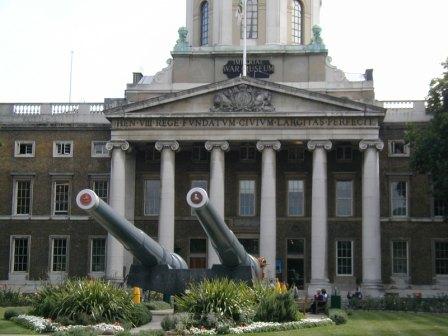
|
The museum was founded to display and collect material relating to The Great War but now commemorates all military operations in which British or Commonwealth forces have been involved since 1914. The site is open to the public daily with no admission charge, and is located in Lambeth Road, London. Geraldine Mary Harmsworth Park, in which the museum is located, was also used for filming in the story, masquerading as Kensington Gardens. The nearest public transport are Lambeth North and Waterloo underground stations.
Leadenhall Market
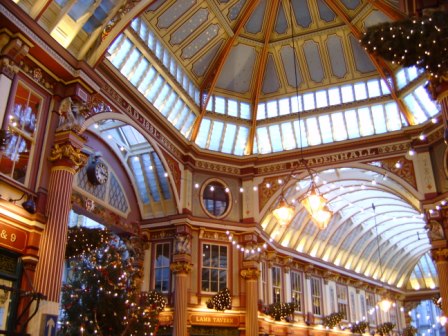 |
Leadenhall Market appears in 'The Rameses Connection' as the site of a chase between Adam (on rollerblades) and Millicent's abductors (in a vintage car). Adam is seen passing through Leadenhall Market twice (although, bizarrely, he seems to pass down an alley in EC4 and past St Paul's Cathedral between these two instances, suggesting a circular chase of several miles circumference!).
(Left and Below) The ornate decoration and attractive roofing of Leadenhall Market, seen in January 2006.
|
|
Leadenhall
Market in the City of London has been a market location since the
14th century. For centuries it was famous for its poultry, meat and
fish, and was also the market designated for cheesemongers. At least
one fishmonger, and at least one cheese merchant remain in place in
the market to the current day. In its modern incarnation, it is a
retail plaza with cobbled streets and a wrought iron and glass roof
(designed in 1881) to lend atmosphere and shelter. It is also host to
a number of bars, pubs and coffee shops. This location is just around
the corner from Mark Lane (see above) and is
within walking distance of Tower Hill or Bank stations on the London Underground.
The market is also noteworthy as a filming location for the film of 'Harry Potter and the Philosopher's Stone' in which it appears as the muggle-world entrance to Diagon Alley.
|
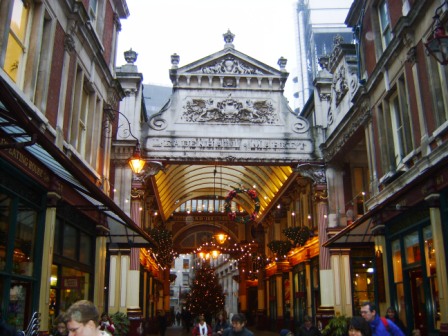 |
L'Hirondelle Club
The Hirondelle Club in Regents Street, W1, appeared on screen as the ZuZu club - apparently located in Cairo.L'Hirondelle (which means `The Swallow' in French) was a restaurant and caberet club in the thriving West End of London, not far from the theatre district. It stood at the corner of Regent Street and Swallow Street, from which it took its name. Unfortunately the club no longer exists, the building having either changed hands or been absorbed in the extensive redevelopment of the area.
The nearest underground station is Picadilly Circus on the Bakerloo and Picadilly lines. Regent Street is one of the oldest roads in London. It meets Oxford Street at Oxford Circus and the London Palladium lies off a side street.
London Attractions
A number of London tourist attractions are seen in passing in the NS serials - usually during bus rides or chases. Since they're clearly intended to allow viewers from outside London to get a feel for the drama's setting, it seems appropriate to list them briefly here:
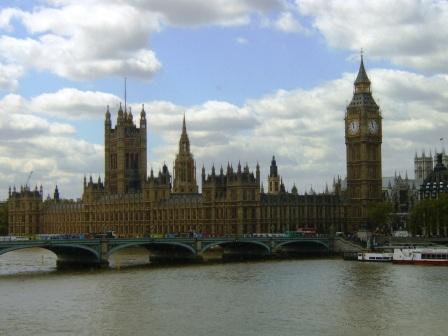
(Above) The Palace of Westminster in May 2005.
|
|
London Parks
After escaping from WorldEx's protective custody, Dr Lucy Connors is found contemplating her options in a London Park. Although the park in question is never named on screen, it is identified in the novelisation of `The Culex Experiment' as Kensington Gardens. However, the scenes in question were actually filmed in Geraldine Mary Harmsworth Park - identifiable through the distinctive Charlotte Sharman School building and sports area in the background.London has many parks, several of which are famous in their own right. The Royal Parks (formerly owned by the crown) comprise Bushy Park, Green Park, Greenwich Park, Hyde Park, Regent's Park, Richmond Park, St James's Park and Kensington Gardens, as well as a number of smaller open spaces. These Royal Parks are cared for by an agency of the Department of Culture, Media and Sport.
Kensington Gardens (originally part of Hyde Park) is a 111 hectare region, dominated by the Albert Memorial and Kensington Palace. It is also famous for its bronze statue of J M Barrie's Peter Pan. The planting and landscaping of the Gardens was shaped by the residents of Kensington Palace, particularly Queen Charlotte (wife of George II). The gardens were originally laid out in 1691 for William III and have been open to the public since at least the early eighteenth century.
Geraldine Mary Harmsworth Park, the green space surrounding the Imperial War Museum, is cared for by Southwark Council. It contains a Tibetan peace garden (opened by the Dalai Lama in 1999) and various sculptures, as well as a picnic area, sporths area and cafe. The park was originally part of St George's Fields, later the grounds of the Royal Bethlem Hospital (known as Bedlam). The park was purchased by Viscount Rothermere after the hospital moved to Beckenham, and named after his mother before being presented to the council. It opened to the public in 1934. The location was presumably used for filming since the artistes in question were all required at the Imperial War Museum for a later scene in the same story.
Lucy Allen's House
| In 'Monsoon Man', Lucy Allen was visited by Adam in her sister's London house. He tracked her down by her railcard in a dropped wallet, which yielded the address of "33 Pricey Mews" (likely a reference to the series' creator Roger Price), although in the novelisation of the serial this was changed to '21 Acorn Road'. In his search for her after her abduction, Adam returned to find an empty house, and also visited several of her neighbours in search of clues.
(Right) The front door of 'Lucy Allen's House', photographed in June 2006 by Emma Hanby (with thanks to Lee Pressman)
|
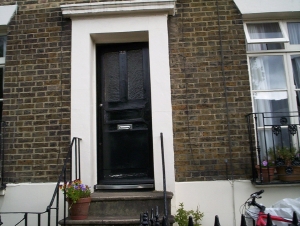 |
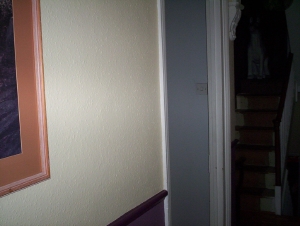 |
Filming for both interior and exterior scenes took place at the home of series co-writer Lee Pressman. The property stands on one of London's characteristic Victorian squares, in a terrace of three storey buildings surrounding a grassed area. Despite its current state of preservation and desirable nature, the terrace stands on part of seventeen acres of land in this area donated to the poor of Lambeth by Edmund Walcot in 1667. The current buildings on the site date from 1837-9. (Left) The hallway of 'Lucy Allen's House' - in which Lucy was abducted by Wilkie, photographed in June 2006 by Emma Hanby (with thanks to Lee Pressman)
|
|
The appearence of an empty house was created using a second property in the terrace - unoccupied at the time - while a third property in the opposite terrace was portrayed the house answered by a Swedish woman who spoke no English.
|
|
 |
 |
| (Above left) The property used to portray an empty house, and (Above right) the Swedish woman's home, photographed in June 2006 by Emma Hanby (with thanks to Lee Pressman) | |
Minster Court
| The distinctive pink granite and Brazilian marble office buildings of Minster Court on Mincing Lane and Mark Lane in the City of London were used to film the exterior of the Cobb Cereal Corporation Headquarters building in 'Monsoon Man'.
(Right) Mark Lane Office Buildings, London, in May 2005. Seen in the morning sunshine from outside Fenchurch Street rail station.
|
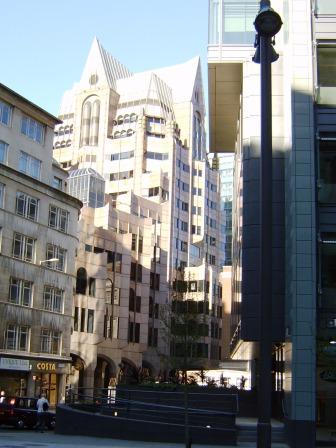 |
 |
The building was built in 1990-91 and opened in 1993, designed by GMW Partnership architects. It is centred around an atrium 60ft in diameter and 130ft tall.
Minster Court lies in the heart of London's financial and insurance district, not far from the Tower of London and Tower Bridge, and is home to the London Underwriting Centre. Tower Hill is the closest underground station, and the building is clearly visible from Fenchurch Street.
|
London Routemaster Buses and Depot
London's classic and long-serving Routemaster bus fleet features heavily in the 'Origin Story'. Kevin Wilson teleports to and from the top deck of a Routemaster, ending up locked in a bus depot and enduing a terrifying rooftop ride at the hands of an insane security guard. Distinctive London buses also appear as the home of Millicent Rutherford in 'The Rameses Experiment', and in the opening sequence of the Original Series documentary 'Beyond Tomorrow'
| Identifying the depot featuring in 'The Origin Story' from the information on screen is challenging. London bus routes 14 and 10 are shown on destination boards, while two Routemaster buses, RM1750 dating from about 1962, and RM121 a 1958 AEC/Park Royal Vehicles Routemaster, are both individually identifiable. Also present in the bus depot is M2559, an MCW Metrobus from about 1980, and a parked bus bearing the fleet name of 'SELKENT' - South East London and Kent Buses. The only depot marking visible is on RM121 which bears the code HT - the Holloway Tram Depot in East London. The HT depot would certainly be appropriate to the number 10 bus route. |
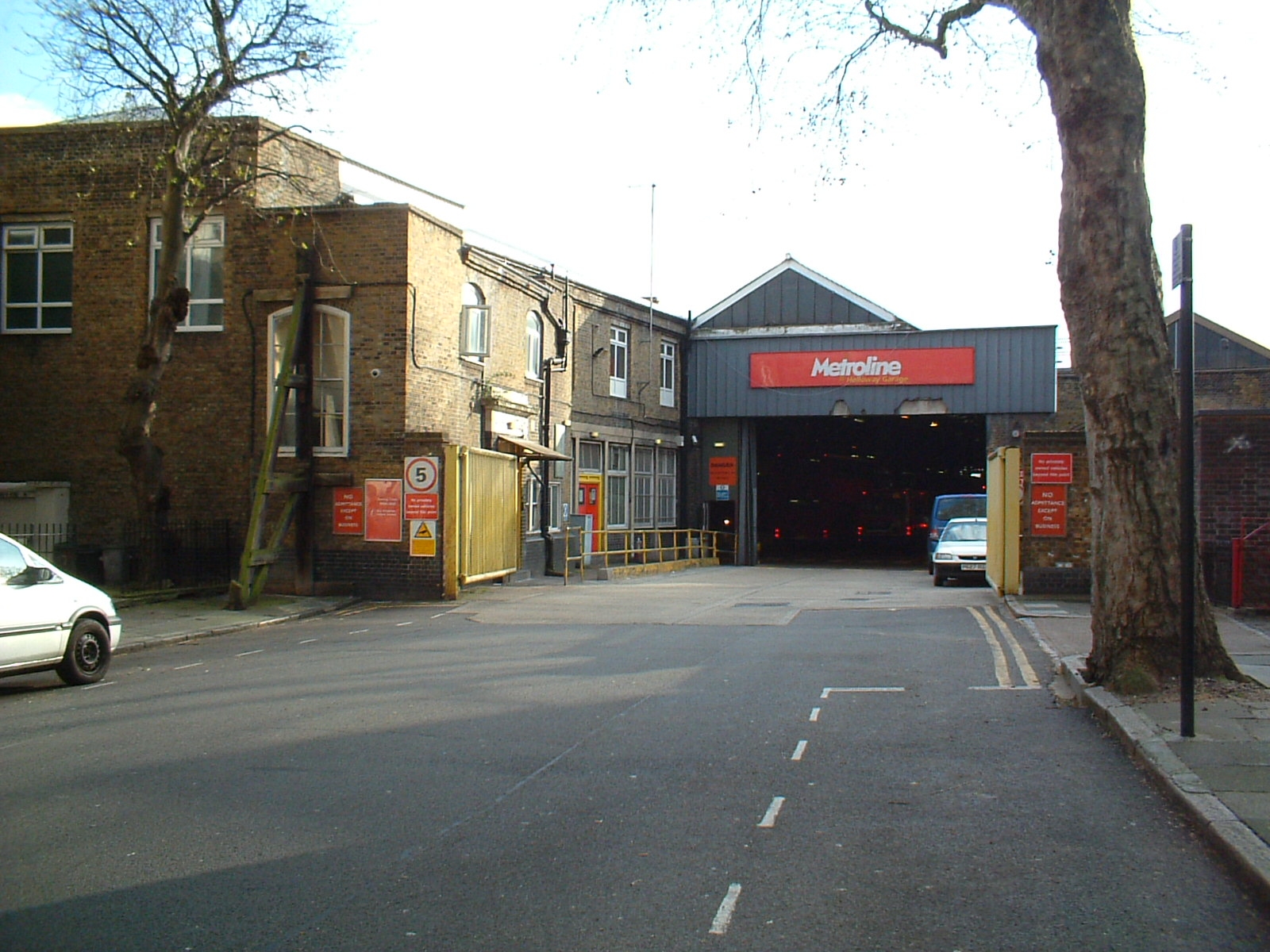
The former Holloway Tram Depot, now operated as a major bus garage by 'Metroline', seen in April 2007 (photo: Len Stanway). |
It is also possible that these scenes were filmed at a location other than a London bus depot but rather at a dealership specialising in ex-London Transport vehicles. Both Routemasters listed above were withdrawn from active service about the time this serial was filmed. (Many thanks to Len Stanway for much of the above information.)
The bus featuring as Millicent's home in 'The Rameses Experiment' is not a classic Routemaster, but rather 'MXX 244', a historic bus now preserved as the London Country Mobile Uniform Store. This model of bus - the London Transport RLH - was designed to pass under low bridges (present on some London routes), and came into service in 1950. This particular vehicle saw service between 1952 and 1974.
The bus which appears in the opening sequence of Beyond Tomorrow is a Routemaster bus - RM 298. This vehicle came into service in 1960 and was withdrawn in 1986. Registered and overhauled in 2001, it is now used on occasional routes, open days and during rail strikes. It was filmed in and around Southgate in August 2005.
Royal School of Mines, Imperial College
Dr Culex, masquerading as a chauffeur, collected police Commander Scott from a large, statue-adorned building in Central London, The Royal School of Mines. Having collected the Commander, Culex drove her down Kensington Gore, past the Royal Albert Hall and Hyde Park - with a mosquito sharing the car.The Royal School of Mines was founded in 1851 by Sir Henry de la Beche, and moved to South Kensington in 1872. In 1907 it merged with the City and Guilds College and Royal College of Science, forming Imperial College, London. It originally developed from the Museum of Economic Geology and early teaching was performed by the Geological Survey. It was a more general science institution than the name suggests, although the focus was on issues related to minerals and metallurgy. The school itself no longer exists as a seperate educational establishment, although the name is retained both for the building and for a student body. and the site is still occupied by Imperial's departments of Materials and Earth Sciences.
The classical-revival building, constructed between 1909 and 1913, was one of several large buildings in the South Kensington area designed by Sir Aston Webb - others including Imperial College and the facade of the Victoria and Albert Museum. The area of academic and museum buildings was nicknamed 'Albertopolis' after the role of Prince Albert in its development after the 1851 Great Exhibition. The later Edwardian building of the Royal School of Mines is constructed in Portland stone and is distinguished by a large apsidal porch. To either side of this recess are two large statue-bearing plinths - memorials to Alfred Beit and Julius Wernher, which were sculpted by Paul Raphael Montford. One of these is visible on screen in `The Culex Experiment' as the shot pans down towards Scott and Culex.
The building is on Prince Consort Road, not far from the museums of South Kensington and close to Hyde Park and the Royal Albert Hall.
Royal Observatory, Grenwich
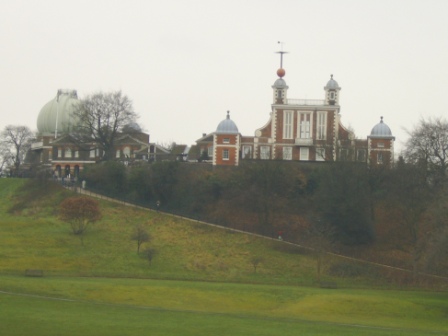
(above) The RGO sits in the middle of a large public park, and atop a steep hill that rises prominently from the Thames Valley. (Photographed January 2006)
|
Ami, Megabyte and Adam visited the RGO in 'The Rameses Connection' while trying to unravel the diabolic plan of Rameses Ak'Hara.
The Old Royal Observatory at Grenwich is now part of the National Maritime Museum. The Observatory was founded by King Charles II in 1675. It stands on the Prime Meridian (0 degrees Longitude) at which Universal Time (Grenwich Mean Time) is defined. A large sphere on top of the observatory allowed vessels in the London docklands to reset their clocks once an hour - an essential process when the measurement of longitude required accurate timekeeping. The meridian itself is marked by a metal line on the ground so it is possible for a visitor to stand with one foot in the western hemisphere, and the other foot in the eastern hemisphere.
|
| For many years, Grenwich was Britain's premier observatory and, correspondingly, was a major centre for the study of time measurement. The observatory is now open to the public as a museum, although public observing is still carried out with the observatory's 28 inch telescope. For a detailed history of the observatory see their website. Greenwich can be reached by public transport, with the Docklands Light Railway (Cutty Sark station being closest) connecting it to central London (passing by Canary Wharf and the London Arena en route). | 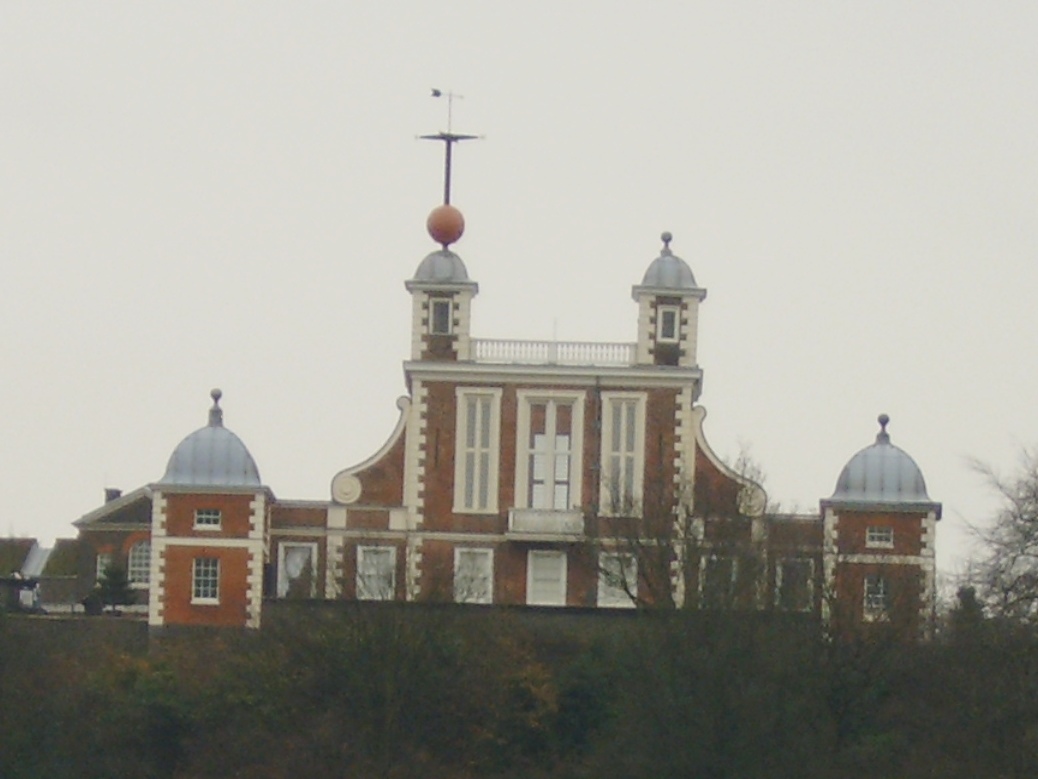
(above) The large sphere above the observatory building falls once every hour, allowing ships on the Thames to reset their clocks. (January 2006) |
UCL Portico and Petrie Museum
|
The classical facade and portico of UCL's Wilkins building on its Gower Street site substitutes for the exterior of the British Museum in 'The Rameses Connection', although UCL's Petrie Museum of Egyptology is too small to have been used for the interior shots (which may in fact have been shot at the British Museum). In fact, the two institutions are located just a couple of hundred metres apart, along Bloomsbury Street and Gower Street. The TPs are seen walking south along Gower Street on their arrival.
University College London was founded in 1826 to open up education to wider social groups than those attending Oxbridge (the only two universities then extant in Britain) and its founder, Jeremy Bentham, aimed to challenge conventional ways of thinking.
|
 (above) UCL's Wilkins building as seen from the Gower Street entrance, May 2005. (Below left) The unassuming entrance to UCL's small Petrie Museum, August 2006.
|
| UCL was the first university in the UK to admit women to degrees on equal terms to men. It is now the largest of the 50 colleges which form the University of London, with some 24,500 staff and students. | |
 |
The Petrie Museum of Egyptian Archaeology at University College London houses the archaeology department's collection of antiquities, used for teaching and research. The museum was founded in 1892 by the bequest of Amelia Edwards, and was radically extended in the first few decades of the twentieth century by archaeology professor William Petrie. The extensive collection of some 80 000 objects is currently housed in a former stable building, although a purpose built museum is planned to open in 2008. The museum is currently open to the public in the afternoon on Tuesdays to Fridays and 10am-1pm on Saturdays although opening is more limited outside of university terms. See their website for details. See the UCL website for a map of its location in London. |